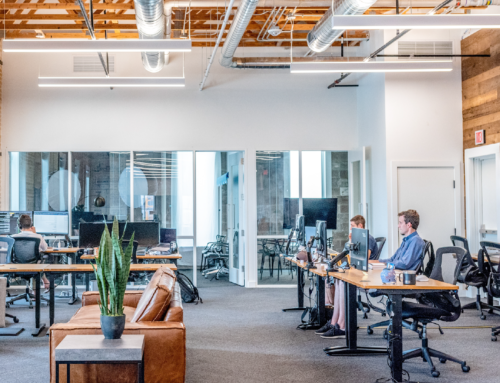Converting offices into housing:
A new reality in the age of telecommuting?
A new reality in the age of telecommuting?
What does the future hold for the office market, particularly in the Paris region? The evolution of the French legislative environment combined with recent changes in the economic environment have had a direct effect on this market. The health crisis and the development of telecommuting have had a profound effect on the market. Many offices are no longer available and some of them have been transformed into housing. A potential still largely under-exploited.
A legislative environment favorable to
for the transformation of offices into housing
for the transformation of offices into housing
The conversion of business real estate assets into housing is strongly encouraged by the legislator. Thought for buildings at the end of their life, the "covid" and "telecommuting" effects have fully played for the development of this type of operation. The Climate and Resilience Act of 2021 is in line with this logic. Since January 1, 2023, the "tertiary decree" has come into force. From now on, any transformation of a building requires a prior "study of the potential for change of use and evolution".
The latest avatar of regulatory change, this obligation is part of the ZAN ("zero net artificialisation" by 2050) and ZEN ("zero net emissions", Energy-Climate law of November 8, 2019) objectives. The law responds in particular to the challenges of reducing the consumption of natural, agricultural and forest areas (NAF), also known as "nibbling" of undeveloped areas. This "nibbling" exploded during the 1980s and 1990s. Under pressure from the State, it has decreased sharply since the year 2000. Today, economic activities represent 25% of the space consumed. A share that continues to grow while the share of housing or transportation remains constant.
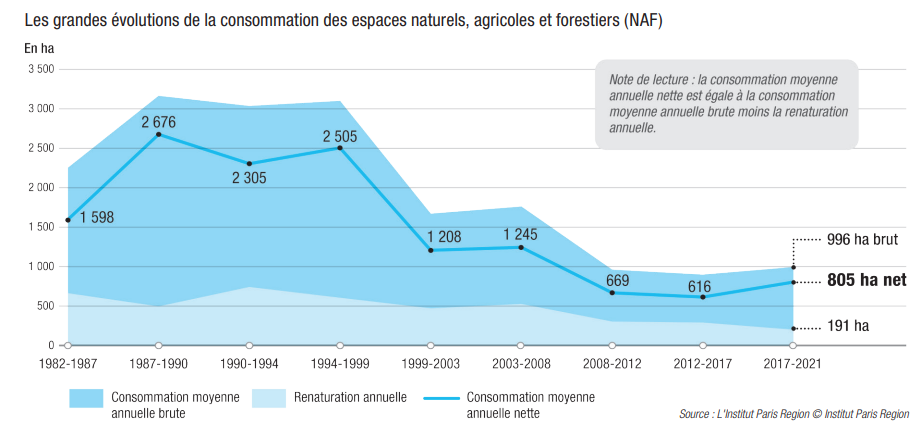
Source document: Institut Paris Région, quoted by the Observatoire du Foncier, 2022
This is why the legislator has decided to strongly encourage companies to make better use of their real estate assets. The ZAN objective aims to transform obsolete buildings in order to avoid the consumption of land by authorizing the densification of urbanized areas.
Objective: to promote the housing/employment balance in tertiary zones and encourage social diversity in tense areas. Under the ELAN law, the legislator provides for an exemption from the PLU for conversion operations. A construction bonus of up to 30% over the initial template can be negotiated with local authorities.
Finally, for owners of assets larger than 1,000 m², the "tertiary decree" of the ELAN law requires them, since September 30, 2022, to transmit the energy data of their buildings to the Ademe (Agency for the Environment and Energy Management). This, in order to set a schedule for reducing the building's GHG emissions. The reduction target can take two forms. The first concerns the energy performance of the building. The second focuses on reaching a target consumption threshold in absolute value. This is set by the "absolute values 2" order of April 13, 2022.
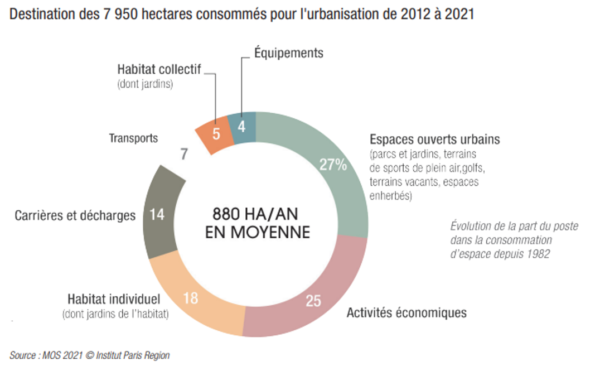
Source document: Institut Paris Région, quoted by the Observatoire du Foncier, 2022
The transformation of offices into housing :
a market that is still confidential and concentrated in Île-de-France
a market that is still confidential and concentrated in Île-de-France
Despite a regulatory environment favorable to its development, this market remains confidential. Since 2013, the administration has authorized 1,900 housing units per year from the conversion of business premises. A little more than half of this housing comes from former offices. Two thirds of these operations are carried out in the Île-de-France region, with one third in the Paris department alone. The Grand Paris 2010 law calls for the construction of 70,000 housing units per year. These conversion operations represent only 3% of this objective. As the Paris Region Institute points out, there are several reasons for this state of affairs. While public and private buildings, as well as overhead parking lots, are eligible for this type of operation, several logics can clash and slow down their implementation.
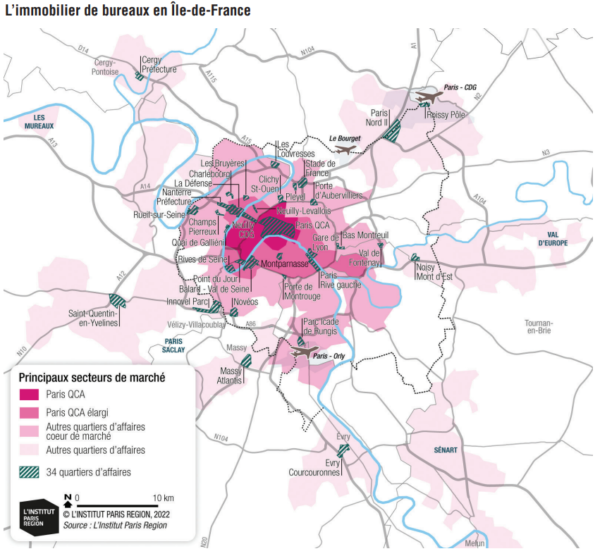
Source document: Institut Paris Région, 2022
Thus, the initial technical design of the building may prevent the feasibility of the operation. The specificities of size, facade, structure or presence of materials such as asbestos are all obstacles. The main technical issue of this type of operation is that the process cannot be "industrialized". Each operation is unique and therefore more expensive than a standardized operation. For public authorities, this type of operation generates higher costs than hosting a professional building (subject to certain negative externalities such as soil pollution). The presence of a professional building generally generates more tax revenue than housing. It also requires less utility spending.
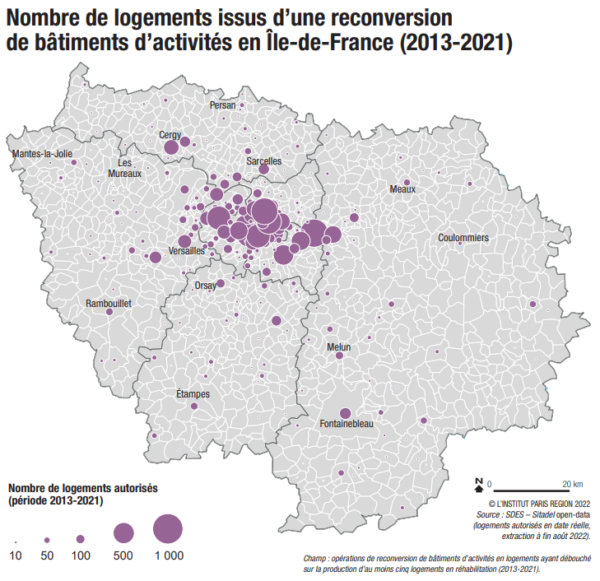
Source document: Institut Paris Région, 2022
So what are the possible developments in this market? As the economic heart of the country, the Paris Region has the largest stock of office space. Among these, we note that the number of assets suffering from vacancy is growing strongly. In 2019, 2.6 million square meters were vacant. By the end of the first half of 2022, there were 4.4 million. Long-term vacancy, that of more than two years, affects 25% of these assets. There is therefore a real market opportunity both on the conversion project side and on the investor side.
- 4.4 million m² of vacant space, including 1.1 million m² of long-term vacancy
- Between 2013 and 2021: 800 operations carried out, 873,000 m² converted
- 1,900 housing units authorized per year, 53% of which are offices
- Two-thirds of national reconversions in Paris and the inner suburbs (32% in Paris)
- 28% of housing converted by social landlords
The most active in this market are social landlords, who have carried out 46% of the housing conversions in Paris and 28% of the housing conversions in the Paris region. More and more public and semi-public companies are also getting involved in this type of operation. La Poste, RATP and Action Logement, for example, are engaging in this type of operation to reconvert or operate their assets.
What scenarios do public actors envisage for developing
the reconversion of office assets?
the reconversion of office assets?
While the number of conversion operations remains modest, the authorities are considering several avenues to support and accelerate them.
WHAT FUTURE FOR PARISIAN OFFICES AFTER THE REVISION OF THE PLU?
Since November 2022, the project to revise the Parisian PLU, integrating bioclimatic standards, has raised a wind of protest among office building owners. With these standards, the Parisian executive wants to develop housing in Paris.
They would oblige owners, on the occasion of a future renovation, to include housing, including social housing, within their office buildings. A prospect that would inexorably lower property values.
Especially since these rules would mainly affect offices located in the central business district (CBD). Valued at between €25,000 and €30,000 for offices, the square meter of these assets could drop drastically: to less than €14,000 if they are converted into housing, and to less than €5,000 if they are converted into social housing.
Among the options being considered, the legislator could require that the reversibility of a building be planned from the outset. Local governments could incorporate these issues into their urban planning documents. We could see a systematic identification of the most suitable buildings. In this respect, the first drafts of the bioclimatic PLU of Paris can give clues as to the modus operandi. In the medium term, the objective could be to double the production of housing resulting from reconversion.
This is why Parella has developed a specific real estate and technical expertise offer (BET) to accompany these operations. Assessing, supporting and innovating in the service of building transformation: Parella's DNA.
Sources
Institut Paris Région / Agefi / LegiFrance / Regional Land Observatory



